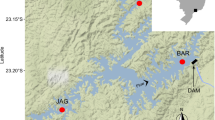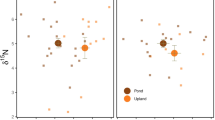Abstract
The planktonic rotifer Brachionus rubens has a propensity for an epizoic mode of life, and in nature is often found attached to cladocerans. In this way the rotifer avoids to a certain extent the adverse effects of interference competition with cladocerans. We test the hypothesis that the epizoic habit of B. rubens acts also as a deterrent against invertebrate predation. Using Asplanchna intermedia as predator, we followed the population growth patterns of B. rubens alone and in the presence of the host species Daphnia carinata and Ceriodaphnia rigaudi. In the absence of cladocerans, the prey was eliminated within three days, followed by extinction of the predator due to starvation. With D. carinata in the medium, the prey-predator system persisted much longer, with B. rubens reaching high population densities. With the smaller-sized C. rigaudi, allowing a significantly smaller fraction of B. rubens population to be epizoic, the system persisted longer than in the controls, but both the prey and predator eventually became extinct. We conclude that the epizoic habit of B. rubens, by acting as a ‘prey refugium’, helps a portion of the population to escape from predation, and facilitates its coexistence with Asplanchna intermedia.
Similar content being viewed by others
References
Burns, C. W. & J. J. Gilbert, 1986. Effects of daphnid size and density on interference between Daphnia and Keratella cochlearis. Limnol. Oceanogr. 31: 848–858.
Garreau, P. F., C. Rougier & R. Pourriot, 1988. Resource exploitation by the planktonic predator Asplanchna girodi de Guerne 1888 (Rotifera) in a sand pit lake. Arch. Hydrobiol. 112: 91–106.
Gause, G. F., 1934. The Struggle for Existence. Williams and Wilkins, Baltimore, 163 pp.
Gause, G. F., 1936. The principles of biocenology. Quart. Rev. Biol. 11: 320–396.
Gilbert, J. J., 1988. Suppression of rotifer populations by Daphnia: A review of the evidence, the mechanisms, and the effects on zooplankton community structure. Limnol. Oceanogr. 33: 1286–1303.
Iyer, N., 1989. Biology of the Predatory Rotifer Asplanchna: A Review and Some Field and Laboratory Studies. M. Phil. Dissertation, University of Delhi, 99 pp.
Iyer, N. & T. R. Rao, 1993. Effect of the epizoic rotifer Brachionus rubens on the population growth of three cladoceran species. Hydrobiologia 255/256 (Dev. Hydrobiol. 83): 325–332.
MacIsaac, H. J. & J. J. Gilbert, 1989. Competition between rotifers and cladocerans of different body sizes. Oecologia 81: 295–301.
Matveeva, L. K., 1989. Interrelations of rotifers with predatory and herbivorous Cladocera: A review of Russian works. Hydrobiologia 186/187 (Dev. Hydrobiol. 52): 69–74.
O'Brien, W. J., 1987. Planktivory by freshwater fish: Thrust and parry in the pelagia. In W. C. Kerfoot & A. Sih (eds), Predation: Direct and Indirect Impacts on Aquatic Communities. The University Press of New England, Hanover (N.H.); Lond.: 3–16.
Schneider, D. W., 1990. Direct assessment of the independent effects of exploitative and interference competition between Daphnia and rotifers. Limnol. Oceanogr. 35: 916–922.
Stemberger, R. S. & J. J. Gilbert, 1987. Defenses of planktonic rotifers against predators. In W. C. Kerfoot & A. Sih (eds), Predation: Direct and Indirect Impacts on Aquatic Communities. The University Press of New England, Hanover (N.H.); Lond.: 227–239.
Williamsom, C. E. & J. J. Gilbert, 1980. Variation among zooplankton predators: The potential of Asplanchna, Mesocyclops, and Cyclops to attack, capture, and eat various rotifer prey. In W. C. Kerfoot (ed.), Evolution and Ecology of Zooplankton Communities. The University Press of New England, Hanover (N.H.); Lond.: 509–517.
Author information
Authors and Affiliations
Rights and permissions
About this article
Cite this article
Iyer, N., Ramakrishna Rao, T. Epizoic mode of life in Brachionus rubens Ehrenberg as a deterrent against predation by Asplanchna intermedia Hudson. Hydrobiologia 313, 377–380 (1995). https://doi.org/10.1007/BF00025973
Issue Date:
DOI: https://doi.org/10.1007/BF00025973




